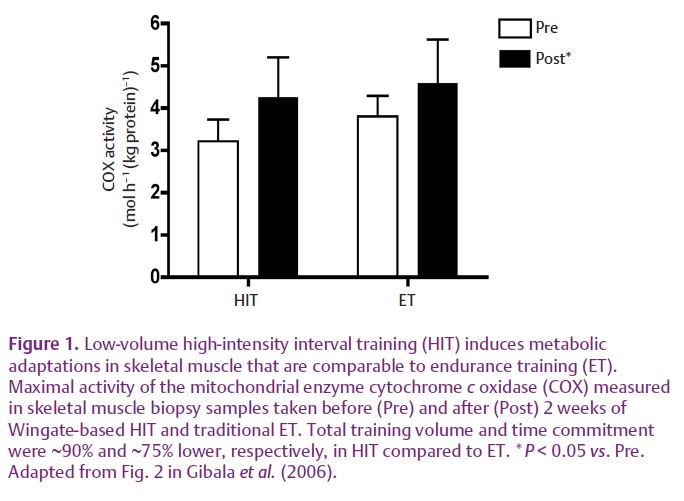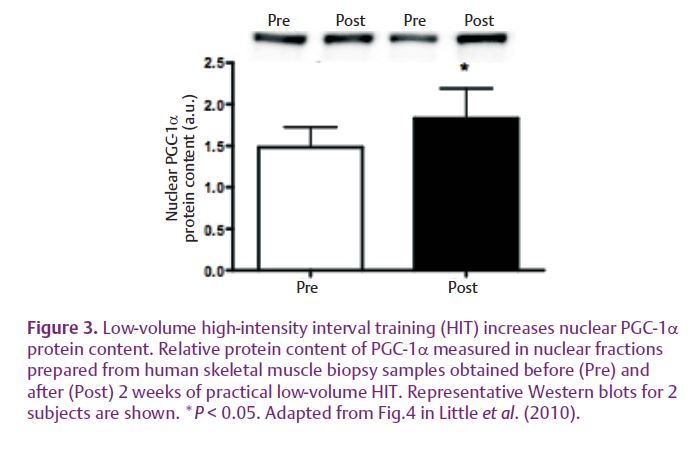
Physiology News Magazine
HIT to get fit: metabolic adaptations to low-volume high-intensity interval training
Low-volume high-intensity interval training (HIT) induces metabolic adaptations that resemble traditional endurance training despite a reduced total exercise volume and time commitment. HIT may therefore represent a time-efficient exercise strategy to improve health. It remains to be determined whether this form of training elicits all of the benefits associated with high-volume continuous exercise, and whether low-volume HIT can be safely and effectively implemented in the general population and persons with chronic diseases.
Features
HIT to get fit: metabolic adaptations to low-volume high-intensity interval training
Low-volume high-intensity interval training (HIT) induces metabolic adaptations that resemble traditional endurance training despite a reduced total exercise volume and time commitment. HIT may therefore represent a time-efficient exercise strategy to improve health. It remains to be determined whether this form of training elicits all of the benefits associated with high-volume continuous exercise, and whether low-volume HIT can be safely and effectively implemented in the general population and persons with chronic diseases.
Features
Jonathan P Little and Martin J Gibala
Department of Kinesiology, McMaster University, Hamilton, Ontario, L8S 4K1, Canada
https://doi.org/10.36866/pn.80.22
Regular endurance exercise training induces numerous adaptations that enhance functional performance, improve health and reduce the risk for chronic disease. While the physiological changes are complex and involve multiple organ systems, metabolic adaptations in skeletal muscle play a critical role in the beneficial effects of endurance training. In particular, exercise-induced increases in muscle oxidative and glucose transport capacities are believed to contribute to the reduced risk of diseases such as insulin resistance and type 2 diabetes (T2D). Recent studies have demonstrated that low-volume, high-intensity interval training (HIT) induces numerous metabolic and performance adaptations that are remarkably similar to traditional endurance training despite a lower total exercise volume and training time commitment (Gibala & McGee, 2008). Given that ‘lack of time’ is the most commonly cited barrier to regular exercise participation, low-volume HIT may represent an attractive alternative for promoting beneficial adaptations in the general population.


What is HIT?
HIT is characterized by brief repeated ‘bursts’ of vigorous exercise inter-spersed with periods of rest or low-intensity exercise for recovery. The training impulse (i.e. interval intensity, duration and number) is infinitely variable, with single efforts lasting from a few seconds up to several minutes. The primary focus of our laboratory in recent years has been on the effects of low-volume HIT. In this type of HIT, the interval training intensity is very high yet the total amount of exercise performed during training is purposefully low. Our HIT training model was the Wingate test, which consists of a 30 s ‘all out’ cycling effort against a standardized resistance. In a typical training session, subjects completed four to six Wingate tests, interspersed with 4 min of rest in between bouts. Thus, training sessions consisted of only 2–3 min of maximal exercise and required a training time commitment of ~20–25 min. Six sessions of this low-volume HIT protocol over 2 weeks is a potent stimulus to increase muscle oxidative capacity and enhance endurance performance (Fig. 1) (Gibala et al. 2006). This same protocol was also recently reported to improve insulin sensitivity, as shown by a study in press in The Journal of Physiology that applied the hyperinsulinaemic-euglycaemic clamp technique in overweight men (Richards et al. 2010). These findings highlight the potential for low-volume HIT to improve metabolic health.

The need for a more practical model of HIT
Wingate cycling tests require a specialized cycle ergometer and the ‘all-out’ maximal effort necessitates an extremely high level of subject motivation. Therefore, the aforementioned low-volume HIT protocols are very demanding and may not be safe or practical to implement in the general population. In a recent publication in The Journal of Physiology (Little et al. 2010), we evaluated whether a more practical model of low-volume HIT could elicit metabolic and performance adaptations similar to our previous Wingate-based HIT studies. The practical model was designed to keep total training time commitment relatively low (requiring approximately 1 h per week), decrease the absolute intensity of the intervals, and be performed on a standard stationary bicycle similar to that found in fitness clubs or home gyms. The modified HIT protocol involved 8–12 x 1-min intervals at an intensity that corresponded to ~100% peak oxygen uptake with 75 s rest periods in between (Fig. 2). While still a demanding form of exercise, the absolute work intensity corresponded to less than half of that achieved during an all-out Wingate test. Despite these modifications, the training was still ‘time efficient’ in that only ~10 min of exercise was performed over a 15–25 min period during each training session.

Six sessions of this modified HIT protocol over 2 weeks was a sufficient stimulus to increase functional exercise performance, assessed using cycling time trials, and enhance skeletal muscle oxidative capacity, assessed by measuring the protein content and maximal activity of selected mitochondrial enzymes. Skeletal muscle glucose transporter (GLUT4) content and resting muscle glycogen content were also increased following training. These latter findings provide additional support for the potential benefits of low-volume HIT for improving glycaemic regulation. We also examined the effects of training on several proteins that are implicated in regulating the muscle adaptive response. Training increased the content of the transcriptional regulatory protein peroxisome proliferator-activated receptor γ co-activator (PGC)-1α measured in nuclear fractions (Fig. 3) yet total PGC-1α appeared unchanged. PGC-1α has emerged as an important regulator of mitochondrial and metabolic gene expression by virtue of its ability to co-activate numerous transcription factors in the nucleus. The increase in nuclear PGC-1α suggests that low-volume HIT increases the activation of this critical regulatory protein. Evidence suggests that PGC-1α activation is reduced in conditions of obesity, insulin resistance, T2D and ageing. The ability of low-volume HIT to increase PGC-1α activation provides mechanistic support for the potential health benefits of this type of time-efficient exercise training.

Future directions
Despite evidence for low-volume HIT to promote metabolic adaptations linked with improved health, more research is required to determine whether HIT elicits all of the benefits associated with traditional endurance training. An accumulating body of research indicates that interval-based exercise induces superior cardiovascular benefits compared with continuous aerobic training matched for total work (Wisloff et al. 2009). Whether low-volume HIT is of similar benefit to cardiovascular health requires further investigation. In addition, most of the low-volume HIT research published to date has involved relatively short-term training protocols (up to 6 weeks) and additional studies are warranted to examine the long-term adaptations to this type of training. Finally, it remains to be determined whether our practical low-volume HIT model (Little et al. 2010) can be implemented in a wide variety of populations. Encouragingly, recent unpublished work from our laboratory suggests that this HIT model is well-tolerated and can improve muscle oxidative capacity and markers of glycaemic control in sedentary, middle-aged adults as well as individuals with T2D. Low-volume HIT may therefore represent an attractive time-efficient exercise alternative for reducing the risk of metabolic disease.
References
Gibala MJ, Little JP, van Essen M, Wilkin GP, Burgomaster KA, Safdar A, Raha S & Tarnopolsky MA (2006). Short-term sprint interval versus traditional endurance training: similar initial adaptations in human skeletal muscle and exercise performance. J Physiol 575, 901–911.
Gibala MJ & McGee SL (2008). Metabolic adaptations to short-term high-intensity interval training: a little pain for a lot of gain? Exerc Sport Sci Rev 36, 58–63.
Little JP, Safdar A, Wilkin GP, Tarnopolsky MA & Gibala MJ (2010). A practical model of low-volume high-intensity interval training induces mitochondrial biogenesis in human skeletal muscle: potential mechanisms. J Physiol 588, 1011–1022. http://jp.physoc.org/content/588/6/1011.long
Richards JC, Johnson TK, Kuzma JN, Lonac MC, Schweder MM, Voyles WF & Bell C (2010). Short-term sprint interval training increases insulin sensitivity In healthy adults but does not affect the thermogenic response to β-adrenergic stimulation. J Physiol. [Epub ahead of print]. Published online 14 June 2010.
Wisloff U, Ellingsen O & Kemi OJ (2009). High-intensity interval training to maximize cardiac benefits of exercise training? Exerc Sport Sci Rev 37, 139–146.
